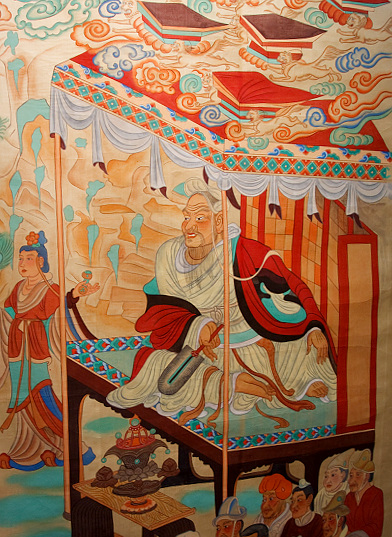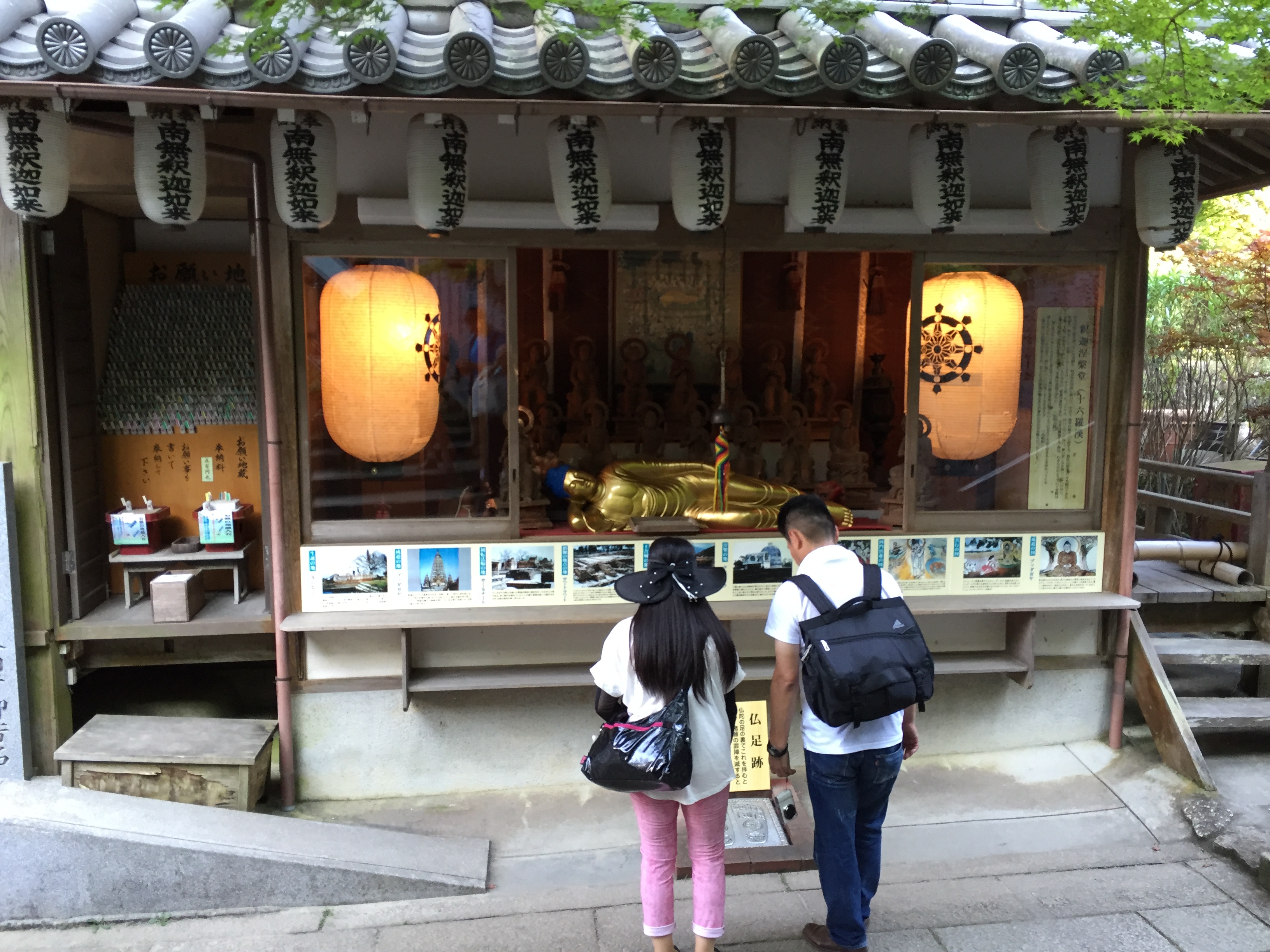|
Daosheng
Daosheng (; ca. 360–434), or Zhu Daosheng (), was an eminent Six Dynasties era Chinese Buddhist scholar. He is known for advocating the concepts of sudden enlightenment and the universality of the Buddha nature. Life Born in Pengcheng, Daosheng left home to become a monk at eleven. He studied in Jiankang under Zhu Fatai, and later at Lushan (Mount Lu) monastery with Huiyuan, and from 405 or 406 under Kumarajiva in Chang'an, where he stayed for some two years perfecting his education. He became one of the foremost scholars of his time, counted among the "fifteen great disciples" of Kumarajiva. Sengzhao reports that Daosheng assisted Kumarajiva in his translation of the Lotus Sutra, Daosheng wrote commentaries on the Lotus Sutra, the Vimalakirti-nirdesa Sutra and the Astasahasrika-prajnaparamita Sutra (the last of which has been lost). In 408, he returned to Lushan, and in 409 back to Jiankang, where he remained for some twenty years, staying at the Qingyuan Monaster ... [...More Info...] [...Related Items...] OR: [Wikipedia] [Google] [Baidu] |
Lotus Sutra
The ''Lotus Sūtra'' ( zh, 妙法蓮華經; sa, सद्धर्मपुण्डरीकसूत्रम्, translit=Saddharma Puṇḍarīka Sūtram, lit=Sūtra on the White Lotus of the True Dharma, italic=) is one of the most influential and venerated Buddhist Mahāyāna sūtras. It is the main scripture on which the Tiantai, Tendai, Cheontae, and Nichiren schools of Buddhism were established. It is also influential for other East Asian Buddhist schools, such as Zen. According to the British Buddhologist Paul Williams, "For many Buddhists in East Asia since early times, the ''Lotus Sūtra'' contains the final teaching of Shakyamuni Buddha—complete and sufficient for salvation." The American Buddhologist Donald S. Lopez Jr. writes that the ''Lotus Sūtra'' "is arguably the most famous of all Buddhist texts," presenting "a radical re-vision of both the Buddhist path and of the person of the Buddha." Two central teachings of the ''Lotus Sūtra'' have been ve ... [...More Info...] [...Related Items...] OR: [Wikipedia] [Google] [Baidu] |
Vimalakirti-nirdesa Sutra
The ''Vimalakīrti Nirdeśa'' (Devanagari: विमलकीर्तिनिर्देश) (sometimes referred to as the ''Vimalakīrti Sūtra'' or ''Vimalakīrti Nirdeśa Sūtra'') is a Buddhist text which centers on a lay Buddhist meditator who attained a very high degree of enlightenment considered by some second only to the Buddha's. It was extremely influential in East Asia, but most likely of considerably less importance in the Indian and Tibetan sub-traditions of Mahāyāna Buddhism. The word ''nirdeśa'' in the title means "instruction, advice", and Vimalakīrti is the name of the main protagonist of the text, and means "Taintless Fame". The sutra teaches, among other subjects, the meaning of nondualism, the doctrine of the true body of the Buddha, the characteristically Mahāyāna claim that the appearances of the world are mere illusions, and the superiority of the Mahāyāna over other paths. It places in the mouth of the upāsaka (lay practitioner) Vimalakīrti ... [...More Info...] [...Related Items...] OR: [Wikipedia] [Google] [Baidu] |
Jin Dynasty (266–420) Buddhists
Jin is a toneless pinyin romanization of various Chinese names and words. These have also been romanized as Kin and Chin (Wade–Giles). "Jin" also occurs in Japanese and Korean. It may refer to: States Jìn 晉 * Jin (Chinese state) (晉國), major state of the Zhou dynasty, existing from the 11th century BC to 376 BC * Jin dynasty (266–420) (晉朝), also known as Liang Jin and Sima Jin * Jin (Later Tang precursor) (晉國; 907–923), Five Dynasties and Ten Kingdoms period * Later Jin (Five Dynasties) (後晉; 936–947), Five Dynasties and Ten Kingdoms period Jīn 金 * Jin dynasty (1115–1234) (金朝), also known as the Jurchen Jin * Later Jin (1616–1636) (後金; 1616–1636), precursor of the Qing dynasty Others * Jin (Korean state) (辰國), precursor of the Jinhan Confederation * Balhae (698–713), originally known as Jin (震) Places * Jin Prefecture (Shanxi) (晉州), a former Chinese prefecture centered on present-day Linfen, Shanxi * Jin Prefecture ( ... [...More Info...] [...Related Items...] OR: [Wikipedia] [Google] [Baidu] |
434 Deaths
__NOTOC__ Year 434 ( CDXXXIV) was a common year starting on Monday (link will display the full calendar) of the Julian calendar. At the time, it was known as the Year of the Consulship of Aspar and Areobindus (or, less frequently, year 1187 ''Ab urbe condita''). The denomination 434 for this year has been used since the early medieval period, when the Anno Domini calendar era became the prevalent method in Europe for naming years. Events By place Roman Empire * Flavius Aetius, Roman general (''magister militum'') in the service of Emperor Valentinian III, begins to hold power in Rome (this will continue for 20 years). He allows the Huns to settle in Pannonia, along the Sava River. * Justa Grata Honoria, older sister of Valentinian, becomes pregnant from an officer in her household. Circles in the court at Ravenna assume inevitably that Honoria is planning to raise her paramour to imperial rank and challenge her brother. Valentinian then has him executed. * Summer ... [...More Info...] [...Related Items...] OR: [Wikipedia] [Google] [Baidu] |
Chán
Chan (; of ), from Sanskrit '' dhyāna'' (meaning " meditation" or "meditative state"), is a Chinese school of Mahāyāna Buddhism. It developed in China from the 6th century CE onwards, becoming especially popular during the Tang and Song dynasties. Chan is the originating tradition of Zen Buddhism (the Japanese pronunciation of the same character, which is the most commonly used English name for the school). Chan Buddhism spread from China south to Vietnam as Thiền and north to Korea as Seon, and, in the 13th century, east to Japan as Japanese Zen. History The historical records required for a complete, accurate account of early Chan history no longer exist. Periodisation The history of Chan in China can be divided into several periods. Zen, as we know it today, is the result of a long history, with many changes and contingent factors. Each period had different types of Zen, some of which remained influential while others vanished. Ferguson distinguishes thr ... [...More Info...] [...Related Items...] OR: [Wikipedia] [Google] [Baidu] |
Nirvana Sutra
( , , ; sa, निर्वाण} ''nirvāṇa'' ; Pali: ''nibbāna''; Prakrit: ''ṇivvāṇa''; literally, "blown out", as in an oil lampRichard Gombrich, ''Theravada Buddhism: A Social History from Ancient Benāres to Modern Colombo.'' Routledge) is a concept in Indian religions (Buddhism, Hinduism, Jainism, and Sikhism) that represents the ultimate state of soteriological release, the liberation from duḥkha and ''saṃsāra''. In Indian religions, nirvana is synonymous with ''moksha'' and ''mukti''. All Indian religions assert it to be a state of perfect quietude, freedom, highest happiness as well as the liberation from attachment and worldly suffering and the ending of ''samsara'', the round of existence.Gavin Flood, ''Nirvana''. In: John Bowker (ed.), '' Oxford Dictionary of World Religions'' However, non-Buddhist and Buddhist traditions describe these terms for liberation differently. In Hindu philosophy, it is the union of or the realization of the identity of ... [...More Info...] [...Related Items...] OR: [Wikipedia] [Google] [Baidu] |
Mahaparinirvana Sutra
In Buddhism, ''parinirvana'' (Sanskrit: '; Pali: ') is commonly used to refer to nirvana-after-death, which occurs upon the death of someone who has attained ''nirvana'' during their lifetime. It implies a release from '' '', karma and rebirth as well as the dissolution of the ''skandhas''. In some Mahāyāna scriptures, notably the ''Mahāyāna Mahāparinirvāṇa Sūtra'', ''parinirvāṇa'' is described as the realm of the eternal true Self of the Buddha. In the Buddha in art, the event is represented by a reclining Buddha figure, often surrounded by disciples. Nirvana after death In the Buddhist view, when ordinary people die, each person's unresolved karma passes on to a new birth instantaneously; and thus the karmic inheritance is reborn in one of the six realms of '' samsara''. However, when a person attains nirvana, they are liberated from karmic rebirth. When such a person dies, it is the end of the cycle of rebirth, the Samsara and the Karma. Contemporary scholar Ru ... [...More Info...] [...Related Items...] OR: [Wikipedia] [Google] [Baidu] |
Icchantikas
In Mahayana Buddhism the ''icchantika'' is a deluded being who can never attain enlightenment (Buddhahood). Description According to some Mahayana Buddhist scriptures, the ''icchantika'' is the most base and spiritually deluded of all types of being. The term implies being given over to total hedonism and greed. In the Tathagatagarbha sutras, some of which pay particular attention to the ''icchantikas'', the term is frequently used of those persons who do not believe in the Buddha, his eternal Selfhood and his Dharma (Truth) or in karma; who seriously transgress against the Buddhist moral codes and vinaya; and who speak disparagingly and dismissively of the reality of the immortal Buddha-nature (''Buddha-dhatu'') or Tathagatagarbha present within all beings. The two shortest versions of the Mahayana Mahaparinirvana Sutra - one translated by Fa-xian, and the other a middle-length Tibetan version of the sutra - indicate that the ''icchantika'' has so totally severed all his/h ... [...More Info...] [...Related Items...] OR: [Wikipedia] [Google] [Baidu] |
Buddha-nature
Buddha-nature refers to several related Mahayana Buddhist terms, including '' tathata'' ("suchness") but most notably ''tathāgatagarbha'' and ''buddhadhātu''. ''Tathāgatagarbha'' means "the womb" or "embryo" (''garbha'') of the "thus-gone" (''tathāgata''), or "containing a ''tathāgata''", while ''buddhadhātu'' literally means "Buddha-realm" or "Buddha-substrate". Buddha-nature has a wide range of (sometimes conflicting) meanings in Indian and later East Asian and Tibetan Buddhist literature. Broadly speaking, the terms refer to the potential for all sentient beings to be a Buddha, since the luminous mind, "the natural and true state of the mind," the pure (''visuddhi'') mind undefiled by kleshas, is inherently present in every sentient being. It will shine forth when it is cleansed of the defilements, c.q. when the nature of mind is recognised for what it is. The ''Mahāyāna Mahāparinirvāṇa Sūtra'' (written 2nd century CE), which was very influential in the C ... [...More Info...] [...Related Items...] OR: [Wikipedia] [Google] [Baidu] |
Six Dynasties
Six Dynasties (; 220–589 or 222–589) is a collective term for six Han-ruled Chinese dynasties that existed from the early 3rd century AD to the late 6th century AD. The Six Dynasties period overlapped with the era of the Sixteen Kingdoms, a chaotic warring period in northern China after the collapse of the Western Jin dynasty. The term " Wei, Jin, Southern and Northern Dynasties" (魏晋南北朝 h) is also used by Chinese historians when referring to the historical period of the Six Dynasties, although both terms do not refer to the exact same dynasties. Six Dynasties with capitals in Jiankang The six dynasties based in Jiankang (in modern Nanjing) were: # Eastern Wu dynasty (222–280) # Eastern Jin dynasty (317–420) # Liu Song dynasty (420–479) # Southern Qi dynasty (479–502) # Liang dynasty (502–557) # Chen dynasty (557–589) Xu Song (許嵩) from the Tang dynasty wrote a book titled ''Veritable Records of Jiankang'' (建康實錄) that provides a h ... [...More Info...] [...Related Items...] OR: [Wikipedia] [Google] [Baidu] |




